Affiliate disclosure: This post may contain affiliate links. Please see our Privacy Policy.
Dandelion wine captures the essence of summer. Sweet, floral and with subtle notes of honey, dandelion wine is tasty enough to bring out the forager in anyone. It takes quite a few dandelions to make wine, so it’s best to enlist the help of as many small children as possible.
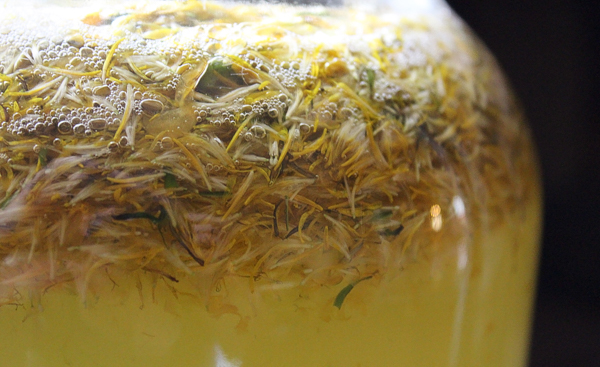
The author of Backyard Medicine talks about how her very first job as a child was collecting dandelions for her neighbor’s dandelion wine. He paid her by the paper sack full and she was happy to do it.
The first time we made dandelion mead, a type of dandelion honey wine, I enlisted the help of a 4-year-old neighbor girl. She picked enough dandelions for a 5-gallon batch in about an hour.
After that, every time I saw her for the rest of the summer she would bring me dandelions. That little neighbor girl is a teenager now, and I have my own daughter to lend a hand.
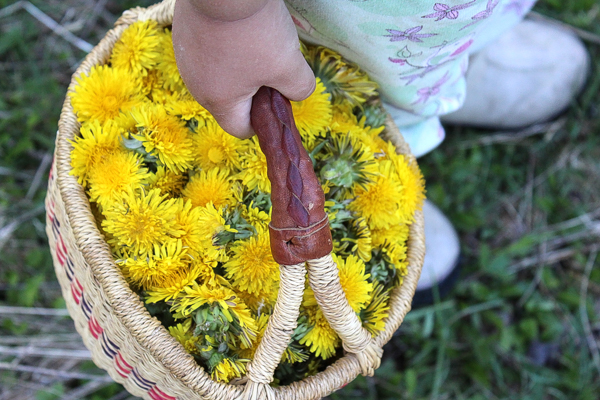
The real work in making dandelion wine is not collecting the dandelions. It’s in splitting apart the dandelions and removing the green leaves from each blossom. The green leaves have a milky sap that will ruin the taste of dandelion wine, and a good batch only uses the petals.
This year, my 3-year-old daughter picked about a gallon of blossoms in about 15 minutes, but we spent over an hour picking the petals from the flower heads.
It’s pleasant work for a warm afternoon, and I had my best girl sitting across from me. I successfully bribed her for the task by promising that some of the blossoms would be used to make dandelion ice cream.
(Since then I’ve bribed the littles with dandelion cookies, dandelion marshmallows, and even dandelion gummy bears…there’s a reason I have so many dandelion recipes in my back pocket…and that reason is wine!)
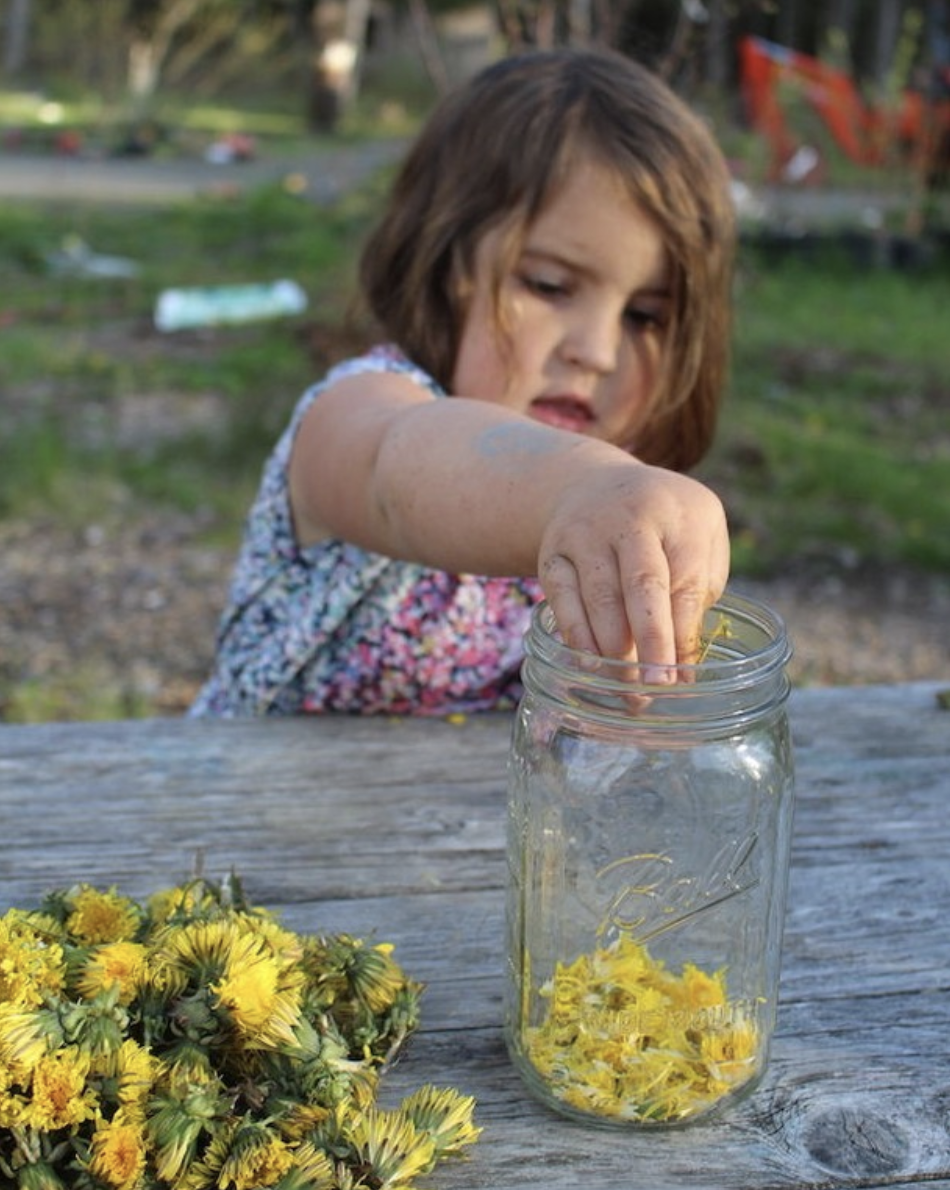
Given that it’s a bit labor-intensive to clean dandelion flowers for wine, plan on making a small batch.
You can make a 5-gallon batch in a traditional carboy, but unless you’ve got a lot of devoted friends, your fingers will likely give out before you have enough dandelion petals.
I had originally planned to make a super tiny 1-quart batch in a quart mason jar. It’s easy enough to attach a mason jar fermentation kit and brew on a very tiny scale.
In the end, we made better progress than I’d anticipated and ended up with enough petals for a full one-gallon batch of dandelion wine.
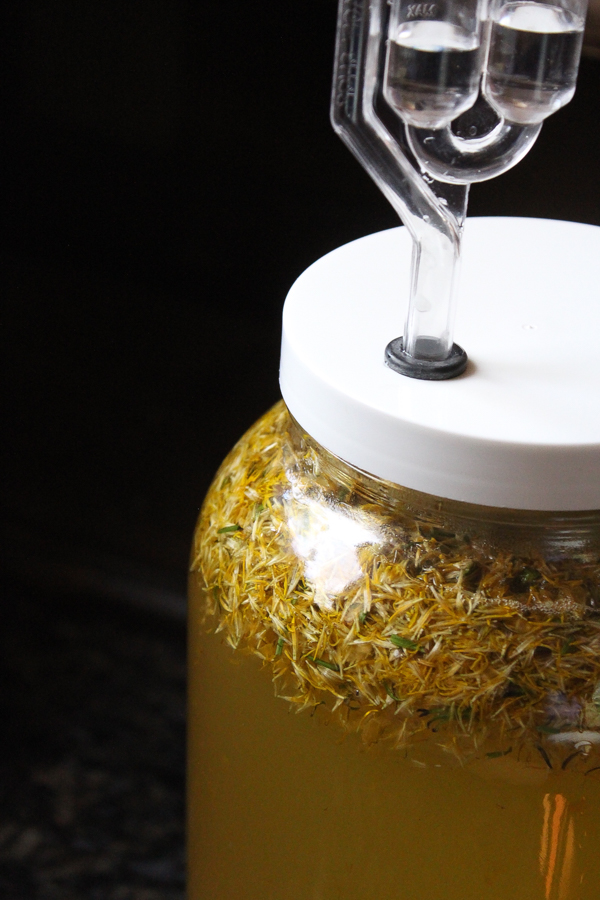
That means I get to try out my new wide mouth one-gallon carboy. If you’ve ever tried to clean out a narrow neck carboy after you’ve brewed with flower petals or any other small particulate, you’ll understand why the wide mouth is so convenient.
Dandelion petals will glue themselves to the inside of the neck of your fermentation vessel and you’ll be scrubbing with a bottle brush for a while unless you use something big enough to get a hand into.
After the primary ferment, the dandelion petals need to be filtered out as the wine is racked into a clean secondary fermentation vessel.
The wide mouth on this fermenter makes that an easy job, and you can just scoop the floating flower petals off the surface before racking.
Racking is a winemaking term, but it just means transferring the wine to a new clean container while leaving the sediment at the bottom behind. This is often done with a siphon for the best results, but it can be done by just pouring the wine carefully into a new container.
It helps to have 2 fermentation vessels, so there’s a clean one waiting, but lacking that, pouring the dandelion wine into a pair of half-gallon mason jars temporarily while you wash out the fermenter works too.
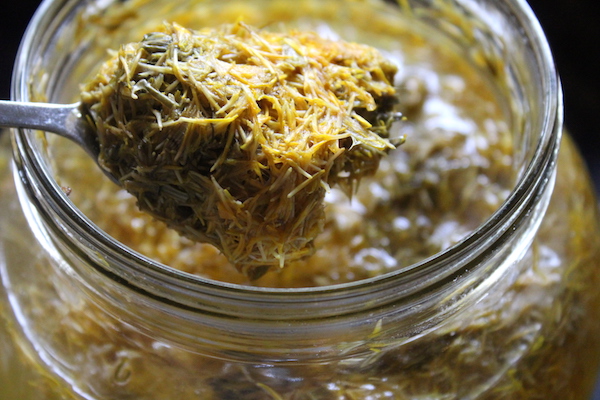
This dandelion wine is made using a cold infusion, which means that the sugar syrup goes in cold, and more of the floral flavor of the dandelions is preserved in the final wine.
You can just make a dandelion tea and filter out the petals before brewing, but the hot water used to make the tea will drive off some of the volatile flavors of the dandelions, and the resulting wine will taste a bit different.
Still, making a tea is much cleaner than brewing with flower petals in the fermenter, and you won’t run the risk of the flower petals bubbling up into the airlock and clogging up the works. If that does happen, just take off the airlock and clean things out before putting it all back together.
If you’re lacking a siphon or other brewing equipment, you can simply brew up this dandelion wine in a pair of half-gallon mason jars equipped with inexpensive silicone water locks. Once the primary ferment is over, scoop off the dandelion petals and carefully pour the wine through a fine mesh strainer into the secondary, leaving the sediment behind.
Reattach a water lock and you’re good to go until bottling time.
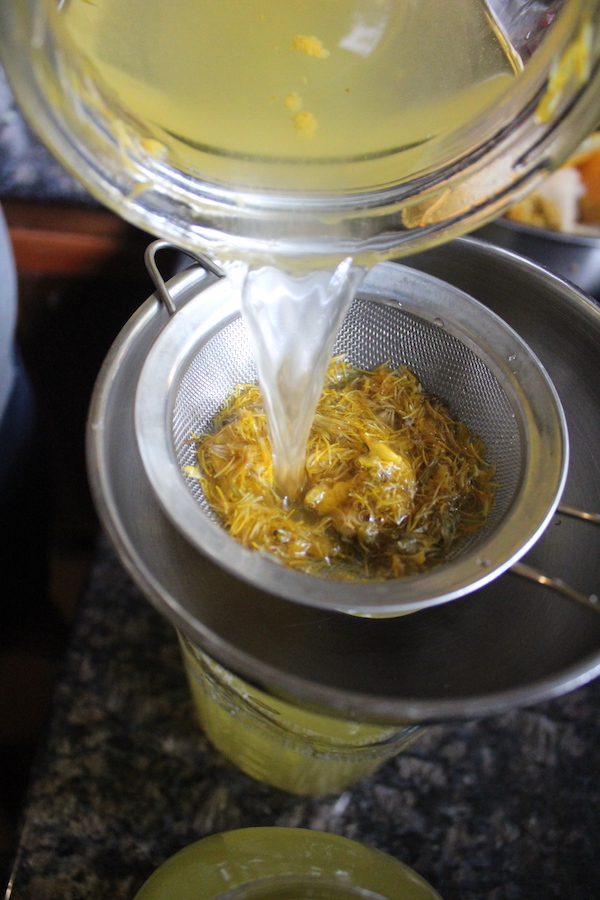
The final wine has a cleaner flavor if you don’t add raisins to the batch, but the yeast work more efficiently with either a few raisins in the wine to provide micro-nutrients that are missing from plain table sugar.
You can also add 1 teaspoon of yeast nutrient to the dandelion wine which will provide nutrients for the yeast without changing the flavor of the finished wine.
That’s really the best solution for the best dandelion wine quality.
How Does Dandelion Wine Taste?
If you’ve done it right, a propper dandelion wine tastes sweet, mild, and floral. You can almost feel the sunshine splash against your tongue, and it goes down smooth with no hints of bitterness.
We tried this batch in January, after about 6 months in the bottle and it was just right. More importantly, it was just what I needed on a cold Vermont evening, with more snow in the forecast and several feet already down on the ground.
Spring will come again, and sipping this little beauty brings me hope.
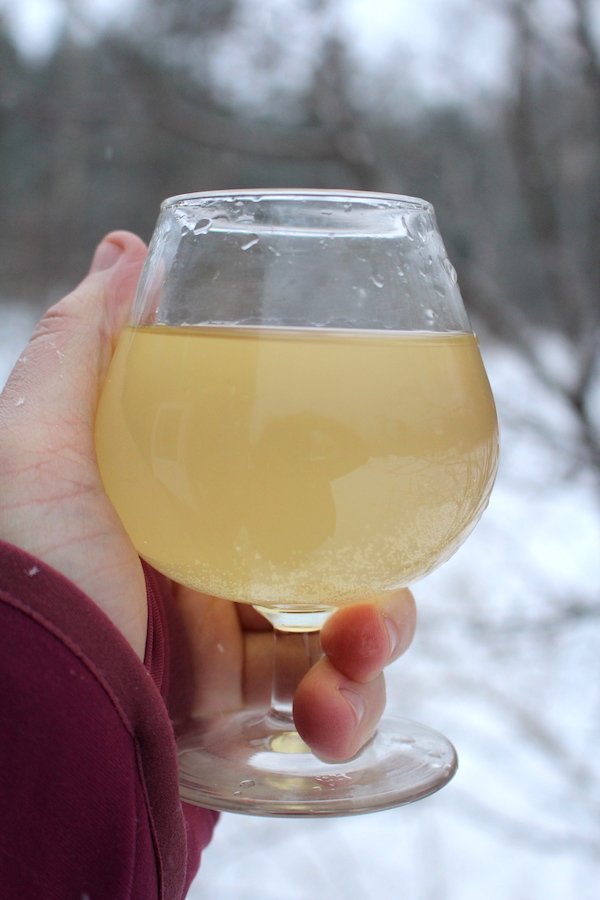
Winemaking Recipes
Looking for more ways to fill your glass with homemade wine?
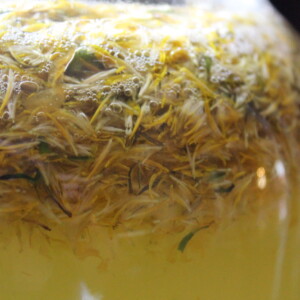
Dandelion Wine
Equipment
Ingredients
- 3 quarts water, approximate, more to fill
- 3 pounds sugar , roughly 5 to 6 cups
- 1- quart dandelion petals, packed from roughly 3-4 quarts blossoms
- 3 medium oranges, juice and zest
- 1 medium lemons, juice and zest
- 1 tsp yeast nutrient
- 1 packet wine yeast
Instructions
- Bring the water and sugar to a boil in a saucepan. Stir to dissolve the sugar and cool to lukewarm.
- Place the dandelion petals, citrus juice and zest into a one-gallon fermentation vessel. Add the yeast nutrient and pour the lukewarm sugar water over the top.
- Dissolve a packet of champagne yeast or other wine yeast in lukewarm water. Allow it to stand for 5 minutes to rehydrate and then pour it into the wine. Top off with a bit of extra water to bring to fill the carboy, but be sure to leave at least an inch of headspace.
- Cap with an airlock and ferment for about 3 weeks or until fermentation has stopped. It will take a bit longer if you don’t use raisins because they provide extra micro-nutrients to get the yeast working faster.
- Siphon the wine into a clean container, leaving the yeast sediment behind. Allow the wine to ferment in secondary for at least 6 to 8 weeks, checking the water lock periodically to ensure that the water hasn’t evaporated.
- Sciphon the dandelion wine into a clean container, again leaving the sediment behind, to prepare for bottling.
- Bottle the dandelion wine in corked wine bottles for longer storage, or flip top Grolsch bottles for tiny batches you’re not planning on storing long.
- Allow the wine age in the bottle at least 2 months before drinking, ideally 6 months or more. Note: During aging, the wine should be kept somewhere cool-ish like a basement or closet on the north side of the house.
Nutrition
Nutrition information is automatically calculated, so should only be used as an approximation.
Small Batch Dandelion Wine
If you’d like to make dandelion wine without investing a lot of time, divide the recipe by 4 to make a super small 1-quart batch. It’s a great solution for those that just want to try it, but don’t want to spend all day plucking apart petals.
All you need is a quart mason jar and a mason jar fermentation kit.
A full packet of champagne yeast will be overkill in a quart batch, so be sure to only use about 1/4 of a packet. Save the rest for another small batch brew, and maybe give small-batch mead a try with any of these mead recipes.
More Dandelion Recipes
Fun Facts…There’s actually a Ray Bradbury novel titled Dandelion Wine, where the drink serves as a metaphor for packing all the joys of summer into a single bottle. How’s this for nostalgia…
“The summer of ’28 was a vintage season for a growing boy. A summer of green apple trees, mowed lawns, and new sneakers. Of half-burnt firecrackers, of gathering dandelions, of Grandma’s belly-busting dinner. It was a summer of sorrows and marvels and gold-fuzzed bees. A magical, timeless summer in the life of a twelve-year-old boy.”
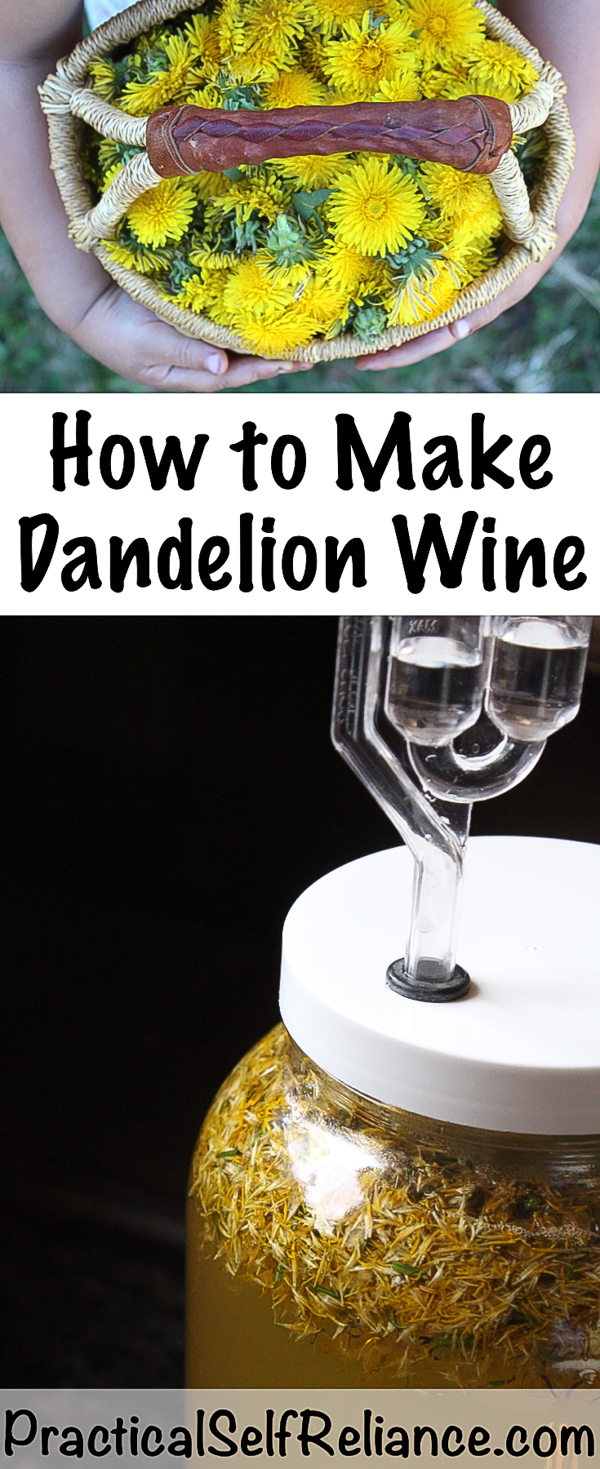
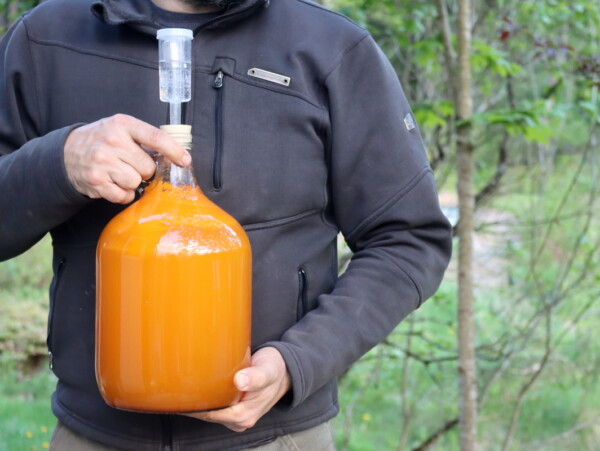



Hi Ashley, Our family has been making Dandelion wine for about 14 years. I’m going to make a batch following your recipe. A few summers ago we made 36 gallons. It took a lot of Dandelion petals. When I harvest the flowers I grab them with one hand & snip the petals off into a bowl using a dedicated pair of scissors. (They get gummed up from the “sap”& need to be cleaned every day). It’s a fast way to harvest Dandelion petals.
Wow, that’s a lot of dandelion wine! We make 5 to 8 gallons a year and I thought that was a lot. I’m impressed! And I’m so glad the recipe is working out for you =)
I’m sorry if I missed this somewhere, but how many bottles does the regular recipe (1 gallon carboy) make? Just making sure I have enough supplies.
One gallon is 128 fluid ounces so you just want enough bottles to contain that amount of liquid.
I’ve been wanting to make dandelion wine as w date idea with my partner but we don’t get enough dandelions that aren’t in areas that get sprayed or exposed to traffic. I was wondering if dried dandelion petals would work for this recipe.
Fresh petals will really give you the best results. Is it possible that you would have enough to do a small batch? Here is the post for that. https://practicalselfreliance.com/small-batch-wine/
Out of curiosity…
I use my Vitamix blender to pretty much liquify fruit batches for everything at home. Just curious if blending dandelion petals this way would possibly pull more flavor from the flowers or possibly just at a faster rate than usual.
I’ve not used that technique before so I can’t really say.
Q: I started making my own batch of dandelion wine, but then I got really busy, and now the initial ferment has lasted nearly 7 weeks instead of three. Is this going to negatively affect it, whether in taste or in safety?
In any case, thanks for the recipe! I heard stories that my grammy’s side of the family made dandelion wine, so your instructions helped me to feel closer to her and have fun doing it.
Did you open it up and smell it? It’s possible that it could have possibly turned into vinegar by now.
Sadly my wine Turner into a slimy mess. I dont know want went wrong. Do you have an ideas why?
I’m so sorry that happened. Is there anything that you did differently from the recipe?
Excited to try this recipe, but it will be my first time making wine. Do I need to sanitize all of the brewing tools (carboy, airlock) and if so, do you have any recommendations for how to do that?
Thanks!
It’s not absolutely necessary but it does result in a more predictable result. You can find a link to the sanitizer we recommend in this post on winemaking tips. https://practicalselfreliance.com/homemade-wine/
Hello! I made this wine and after the fact realized I was supposed to let the water cool before adding it. I added it while it was still hot and then added cool water .Will my wine still turn out?
As long as you didn’t add the yeast directly to the hot water, you should be ok.
Hi there,
Was just wondering if the quarts are Us quarts or imperial quarts? Sorry if that’s a silly question!
Thanks!
Not silly at all. We’re in the U.S. so that would be U.S. quarts.
Hi there! I was wondering if I could make this recipe with dried dandelion flowers?
I wouldn’t recommend it. Typically dandelion flowers turn to fluff whenever you attempt to dry them.
Hello. Thank you so much for this recipe. I made my second batch and I think it came out ok? It’s very very sweet even after reducing the sugar. It’s the same color in your picture but it so sweet I doubt it’s even wine! Is this normal for flavor? Thank you again
Dandelion wine definitely has a sweet taste. How long did you allow it to ferment?
Hi Ashley!
Thank you so much for posting such detailed instructions and great tips – I am enjoying reading through the comments as well. My partner and I are in the process of harvesting enough dandelion flowers to make a full 5 gallon batch! We’re still new to winemaking, and (no pressure for us or anything, haha) this will be our first non-kit wine we make. The timing is right for it, though, and you only get one shot each year during dandelion season!
I have a couple questions for you or anyone else reading:
– Are the oranges and lemon necessary? Does the final product taste like citrus over the dandelions? My partner wants to make a “pure dandelion wine” to really make the most of the dandelion flavour and is concerned that the other flavours will overpower the dandelion blossoms and make it taste just like a “regular old citrus wine” if you know what I mean. He wants to “really be able to call it a dandelion wine.” What would happen if we only used the dandelion blossoms and omitted the oranges and lemons? Would it still taste nice?
– What are your thoughts on using some of the winemaking ingredients such as potassium metabisulfite for stopping fermentation and preserving as well as stabilizing/clarifying agents like kieselsol, chitosan and bentonite? I’m thinking to just follow the regular winemaking procedure and use these ingredients to help with preserving/aging, stabilizing and clearing.
Thanks again! 🙂
You could certainly try it but nearly every recipe I have seen include lemons and oranges. It really shouldn’t be overpowering at all and the cold infusion method really helps the floral notes from the dandelion to shine. One of the reasons why we make our own wine is so that we can avoid the additives that are used in regular winemaking procedures but you’re certainly welcome to use them if you wish.
Dandelion petals freeze nicely. I’ve made batches of wine and mead from dandelions frozen for months as my wide-mouth gallon fermenters are limited. Works fine.
Hi. First: THANK you for all of your experience, wisdom and time and effort you put into post so that people like me can do things we wouldn’t normally do!!! I so appreciate what you do.
I have never made wine. My parents were not wine drinkers. I have wanted to make dandelion wine for a very long time. The funny thing is, I have lived on my 5 acres for over 20 years and have never put weedkiller anywhere. I also have never had dandelions!!! Perhaps a small handful, if that. So, I just ordered dried dandelion flowers. I just now read all the comments, which were very helpful, but noted one reply was that dried flowers may not work as the flavor is gone…(darn!) Do you think that trying it with the dried flowers would be wasting my time effort and ingredients?
Also I noted that at least one of the packets of the “flowers” seems to have quite a lot of the white fluffy stuff….if I did use the dried, would I need to pick this out first?
I guess I COULD wait until I have my own patch of fresh dandelions…
I also have ordered several packets of dandelion seed to plant a large patch this summer…..
Again, thank you for this article and for staying true to your readers by continuing to monitor posts and replying to their questions.
If I were you I would definitely wait until you had some growing rather than using dried. Dandelion is very impossible to dry without it going to seed which is the white fluff that you see. That won’t be good for much of anything other than growing more dandelions.
Hi. I have a couple questions. I am going to be making dandelion wine for the 2nd time this year. Seriously, my yard looks like a dandelion farm. Last yrs batch that I totally ignored, I strained and tried after sitting for a year (no mold). It is SO good, not bitter at all. Actually pretty sweet. This time going to be better about the process. Interesting reading all the comments. I put my quart jar in the back of my pantry, never looked at it but could smell the fermenting each time I opened the pantry. So assume it bubbled.
Wondering if you know about how much alcohol is in this wine. Curious. Corking, is it as simple as getting bottles (sanitized) and corks and pushing the corks in? There are a lot of fancy kits for corking, is that necessary? Want to make more than just the quart this time. That’s all (for now, ha). Thanks for all your great info that you share! It is SO helpful. Peace
This post for watermelon wine goes into detail about the process of bottling with corks and also has links to some suggested equipment. Let us know if you have any other questions. https://practicalselfreliance.com/watermelon-wine/
Thanks for sharing! I started my gallon yesterday and I’m so excited!
You’re very welcome. Please come back and tell us how it turns out.
would it work if we use MonkFruit istead of sugar?
Nope. Monkfruit is indigestible, which is why it’s a keto sweetener. The yeast do need to be able to digest the sugar to do their work.
I just made this over the summer. And while I was supposed to bottle it at the end of August – we ended up bottling it last night. I was so worried that it wouldn’t turn out. We had a bit that wouldn’t fit into bottles, so we drank it and I was so surprised at how good it was. Almost like a dessert wine. So, question. Would leaving it in the secondary ferment for so long make it sweeter?
Thanks for the recipe. I honestly thought I had probably ruined it, but I’m already thinking about what I’ll do differently when I make it next year!
I am so glad you enjoyed the recipe. It shouldn’t make the wine any sweeter by keeping it in the secondary for a longer period of time but it really shouldn’t hurt it either as you have discovered.
Hello,
I’m a rookie at making wine so I have absorbed as much information as I could about a few sweet wines. How sweet is this wine compared to say Moscato de’asti? Will adding potassium sorbate before bottling make it sweeter, or is that even necessary? I have a gallon of dandelion wine fermenting as we speak with a different yeast that was suggested since the store had run out of the right yeast, and I plan on doing a 5 gallon batch when my order comes in from Amazon. I have the dandelion petals in the freezer. 😉 My family thinks I’m crazy to have picked so much without knowing how it tastes. I also plan on doing a one gallon batch of your lilac wine recipe as well as a gallon of rhubarb wine. I know I will be super busy in a few months bottling, but with all the recipes you have, I wanna try them all. LOL
My wife and I don’t really like dry wine. Are there any other recipes you would suggest?
Thank you for these recipes and for offering your experience to us. It is invaluable.
The wine is described as sweet and floral with subtle notes of honey so I really don’t think you will find it to be too dry. The potassium sorbate is not necessary and we actually don’t recommend using it. You would want to use it if you plan to back sweeten the wine but again, I don’t think that will be necessary. I would just start experimenting with the different recipes. You can always do a micro batch to test out a recipe first to see if you like it. You can find the instructions for that here. https://practicalselfreliance.com/small-batch-wine/